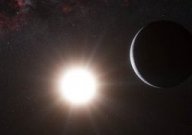Space & Astronomy
January 31, 2013 · 26 comments
26 comments

Image Credit: ESO
Now however the calculations used to determine this zone have been changed thanks to a team of researchers who have undertaken the task of updating the formula. The new measurements would mean that the Earth lies at the very edge of our own Sun's habitable zone and that extrasolar planets once thought to be too hot or too cold might actually be 'just right' after all.
Source: New Scientist | Comments (26)
Solar system 'habitable zone' redefined
By T.K. RandallJanuary 31, 2013 ·
 26 comments
26 comments
Image Credit: ESO
Scientists have updated their calculations for determining if a planet is likely to support life.
The habitable or 'Goldilocks' zone around a star is the region in which the temperature is considered 'just right' for liquid water to exist. Planet hunters have been using this concept to identify which planets around other stars may be able to support life with planets too close to their star being considered too hot and planets further away being considered too cold.Now however the calculations used to determine this zone have been changed thanks to a team of researchers who have undertaken the task of updating the formula. The new measurements would mean that the Earth lies at the very edge of our own Sun's habitable zone and that extrasolar planets once thought to be too hot or too cold might actually be 'just right' after all.
Also known as the Goldilocks zone, because temperatures are "just right" for life there, the habitable zone is the main tool that exoplanet hunters have to rank their finds. But researchers are still using a definition coined in 1993.
Source: New Scientist | Comments (26)

The Unexplained Mysteries
Book of Weird News
AVAILABLE NOW
Take a walk on the weird side with this compilation of some of the weirdest stories ever to grace the pages of a newspaper.
Click here to learn more

Support us on Patreon
BONUS CONTENTFor less than the cost of a cup of coffee, you can gain access to a wide range of exclusive perks including our popular 'Lost Ghost Stories' series.
Click here to learn more
Ancient Mysteries and Alternative History
Earth, Natural Disasters and the Environment
United States and the Americas
UK and Europe
Total Posts: 7,777,501 Topics: 325,492 Members: 203,902
Not a member yet ? Click here to join - registration is free and only takes a moment!
Not a member yet ? Click here to join - registration is free and only takes a moment!




























Please Login or Register to post a comment.